Nature Cure Clinical Pearls
Most of my medicinal herbs are easy to recognize and many people will doubtless have taken the trouble to furnish for themselves a sort of chemist’s shop containing the herbs they have personally collected.
Sebastian Kneipp, 1900, p.143
Nearly all my teas, extracts, oils, and powders are prepared from medical herbs which are to be had for a trifle, and which our dear Lord has planted in our own garden, in the fields, many of them around our houses many on remote, unfrequented spots, so that we can gather them free of cost.
Sebastian Kneipp, 1902, p.384
Every mother knows how to prepare tea. For one cup she takes as much of the dried herbs as she can hold with three fingers, pours boiling water into the little pan upon the tea leaves or blossoms, and lets it boil for some minutes, then she pours out the prepared tea.
Sebastian Kneipp, 1902, p.386
Herbal medicine, as we know it, has many origins that have slipped beyond our gaze. We tend to think of herbs belonging to an earlier era. Associating Father Sebastian Kneipp primarily with hydrotherapy, contemporary naturopathic physicians are not always aware that Kneipp played such an immense role in contributing to herbal medicine, one of the most important modalities in Naturopathy’s therapeutic foundation. Indeed, researching the materials for the 8th book in the Hevert Collection, Herbs in Naturopathic Medicine, brought this fact to my attention strongly. Although the principle author of the majority of the herbal articles found in Benedict Lust’s publications were written by Lust himself, Kneipp was intricately and abundantly interwoven throughout Lust’s publications.
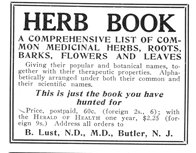
The name, Kneipp, immediately conjures up an image of the Bavarian priest with his garden watering can administering the water gush, or perhaps water treading, or maybe walking barefoot on the grass early in the morning as part of the famous “Kneipp Cure.” Although we do not immediately associate herbs and herbal formulas with Sebastian Kneipp, when we look at Lust’s early publications, we soon realize that Kneipp’s influence upon Naturopathy is much broader than we may have imagined. In Kneipp’s own words: “For long years I have examined and experimented, dried and cut, boiled and tasted. There is not one little herb or powder, which I have not myself tried and found good. My only wish is that my old acquaintances [herbs] may be respected again, at least by one class of people, the poor.” (Kneipp, 1902, p.384) Kneipp confesses that he had deliberated for a long time to introduce herbal remedies fearing that others may perceive them as stemming from his lack of confidence in hydrotherapy.
As endeared to hydrotherapy as Kneipp was, he also recognized that not everyone would embrace cold water therapies as a therapeutic option. Kneipp explains, “There are patients who, from unconquerable fear of water, would have great difficulty in resolving to make a course of water applications, often necessary for some considerable time. I wished to facilitate the cure for them, in other words, to reduce the water applications, to simplify them, and shorten their duration. This can and will be done by giving assistance to the exterior cure (with water) by an interior cure (with remedies).” (Kneipp, 1902, p.384) Kneipp maintained that water cure was an exterior cure, while herbs provided the inner support for the water applications.
Kneipp’s motive for using herbs had another dimension. As a priest in service to his parishioners, he was sympathetic and fully engaged in lightening their hardships and troubles. We must remember that when Kneipp was assigned his parish, he was banished to a remote, impoverished, mountainous village, called Bad [bath] Wöerishofen. Kneipp, himself a son of a poor weaver, knew only too well the struggles of the poor. He often expressed disgust with the high costs of medicaments, especially considering those with no means to pay. Kneipp on this note: “Among all the things which I abhor and hate, the proprietary drugs, the trading with remedies which are kept as a secret by their inventors, hold a prominent place.” (Kneipp, 1902, p.384)
The Kneipp Apotheca
Kneipp divided his herbal tool chest (his “apotheca”) into 4 compartments: extracts, teas, powders and oils. The apotheca was, in his view, a home first aid kit that people could create for themselves by wild crafting and creating the herbal remedies in their own apotheca. He provided clear instructions for such a home apotheca: “Above all, great order is to be kept in the apotheca. … Nothing is more dishonorable to a house than uncleanliness.” (Kneipp, 1902, p.385) He provides careful instructions on the care of the home first aid kit: “The best way to keep the apotheca in good order will be for the mother or a diligent son, or the most cleanly and orderly daughter to take the care and responsibility of it.” (Kneipp, 1902, p.385)
The preparations of the apotheca were precise and clear. When collecting herbs, and berries for the apotheca, the most perfect samples were chosen that were “dried on a wooden board in the open air, but (remember this well) always in the shade, never in the sun”. (Kneipp, 1902, p.386) Extracts were made with corn brandy, which Kneipp preferred, or any other brandy. The extracts, teas and powders were readily obtained in the local countryside where people lived and the oils that Kneipp used could be purchased from the local drugstore.
Kneipp Health Store
When Lust arrived in America with his mission to promote Kneipp’s work, he was quick to establish a health store to sell Kneippian products. The store, called Kneipp Health Store, also was supported by the creation of a publication where Lust could place advertisements featuring the Kneipp formulas and herbs that he sold in his health store in New York City. The very first business that Lust began on September 15th, 1896, at 111 East 59th St. in New York City, was essentially an herbal store selling exclusively Kneipp herbs and other Kneipp products imported from Germany.
To help in his herbal sales, Lust could draw on his own personal experience as a patient at Kneipp’s Wöerishofen where herbal remedies were always at hand. His second resource came directly from the herbal information found in Kneipp’s book, My Water Cure, which outlined 51 herbal remedies, plus the 2 formulations that Kneipp developed, Tonic Laxative formulas I and II, and 12 miscellaneous items that included almond oil, alum, bone powders, bran, chalk and coal powder, cod liver oil, honey, linseed [flax seeds], salad oil, sauerkraut, and secretive oil [its ingredients were not made common knowledge]. (Kneipp, 1896, p.194) We can see by Kneipp’s list that he included plants that were turned into charcoal and food within his medicinal remedies.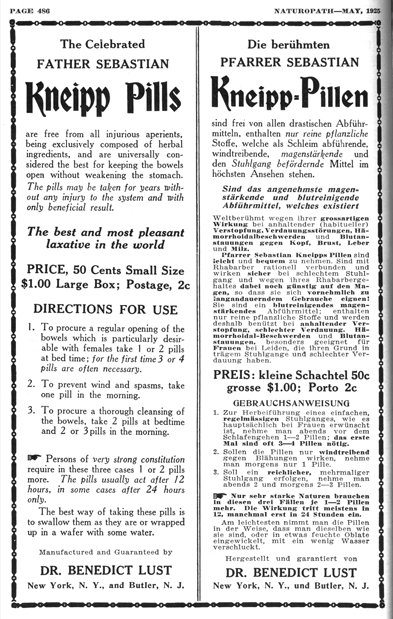
Kneipp’s list of herbs include: althea, aloe, angelica, anise, arnica [German Leopard’s bane], bilberry, agave aloe, black thorn flowers, bogbean, brier hips, chamomile, camphor, caraway, centaury, cloves, coltsfoot, cowslip, elder, dwarf elder, eyebright, fennel, fenugreek, gentian, lungwort, juniper, knotgrass, lavender oil, lime tree blossoms, mallow, mint, mistletoe, mullein, nettle, oak bark, oat, ribwort (plantain), pine resin, rosemary, rue, sage, santala, shavegrass (horsetail), silverweed, St. John’s wort, strawberry leaves, succory (chicory), valerian, violet, woodruff, wormwood, and yarrow. (Kneipp, 1896, pp.128-194) Acknowledging Kneipp’s enthusiasm for locally sourcing herbs and wild crafting, Lust augmented the Kneipp list of herbs with herbs that he found locally.
When we survey this comprehensive list of herbs that Kneipp used in his clinic in Wöerishofen and realize that these were the first herbs used by naturopathic physicians in America, we become curious about how they intended these herbs to be used. In his first issue of The Kneipp Water Cure Monthly (January, 1900), Lust describes the uses for 24 herbs. In 1900, Lust published a total of 7 herbal articles and the number of different herbal plants cited totals 78. Lust’s interest in herbs mushroomed from Kneipp’s original list to include a total of 155 herbs, which would appear in his publications from 1900 to 1923.
There are some herbs that stand out in Kneipp’s books and in the publications of Lust. What makes these herbs pop off the page? Were they new and exotic plants? To the contrary, these plants were quite familiar and commonly available, so common even today that we have perhaps abandoned them during our search for more interesting plants or forgotten about them in the urgency of the latest fad sweeping the naturopathic profession from time to time when new discoveries are made. In any case, reviewing some of the Kneipp herbs conjures up images of old friends that have simply faded into obscurity, displaced by a wave of glamourous newcomers. So, let us dust off a couple of these old-time herbs and view them through the looking glass that Kneipp and Lust would have used. Two herbs that rise to the front of the pack are elder and shavegrass.
Elder, Sambucus nigra
Every part of the elder plant was used for healing. The elder leaves were used in the spring to rid the body of its winter accumulation of body burden. Lust counseled his readers: “Whoever wishes to purify juices and blood by a spring course of medicine, whoever wishes to get rid of injurious matter in the easiest and most natural way, let him take tea of the elder tree leaves.” (Lust, 1900, p.11) The term “morbid matter” was used to describe endotoxins that accumulated in the body from overeating, sedentary habits and poor dietary choices. The elder leaf tea in the spring cleanse was prepared by cutting up 6 to 8 leaves and boiling for 10 minutes. Lust advised: “Take a cup each morning an hour before breakfast until the blood has been thoroughly cleansed of all impurities.” (Lust, 1907, p.199)
We are quite familiar with elder flowers as diaphoretics used to break a cold by perspiration. The tea made from elder root was prized as an excellent remedy to treat edema. Lust explained that it “will drive out the water more powerfully than any other remedy”. (Lust, 1900, p.11) In his role as editor of the “Phytotherapy Department,” a regular column in Lust’s publications from 1915 to 1917, M.G. Young presented a comprehensive analysis of elder and included its properties. Young was billed as the American Herb Doctor in Lust’s column. Young described elder flowers as a diaphoretic and gentle stimulant. He noted that, in cold infusions, elder flowers were diuretic, alterative, and cooling and could be used in hepatic diseases. (Young, 1917, pp.169-170) Young’s recipe for preparing elder berries to be an aperient and alterative was to evaporate the juice of the elder berries “to the consistency of a syrup … one ounce of it will purge.” (Young, 1917, p.170) A blend of elder with maiden hair (Adiantum capillusveneris) and beech drops (Orobanche virginiana) was recommended as a tea formula to treat erysipelas, especially in children. He also noted that the elder root juice “in half ounce doses daily acts as a hydrogogue, cathartic and diuretic and will be found valuable in all dropsical [edematous] affections … and also useful in epilepsy.” (Young, 1917, p.170) For epilepsy, the branches of 1- or 2-year-old elder plants were scraped to remove the gray outer bark. Two ounces of this outer bark were steeped in 5 ounces of cold or hot water for 48 hours. The epileptic patient was given a wineglass [about 4 tablespoons] every 15 minutes when a fit was threatening. (Young, 1917, p.170)
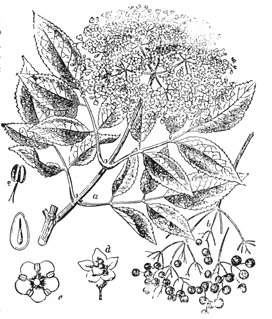 Dwarf Elder, Sambucus ebulus
Dwarf Elder, Sambucus ebulus
Dwarf elder was another important plant within the Kneipp apotheca and in Lust’s commercial interests. Its root was used by Kneipp and Lust for edema or dropsy. “Dwarf elder tea is prepared from the dried roots of the plant, which must be either cut up fine or ground into a powder. … It may also be taken as a powder, half a teaspoon at a time.” (Lust, 1919, p.144) Lust referenced the success of his mentor, Kneipp, in using dwarf elder for edema. Lust recounted, “Rev. Father Kneipp states in several of his reports that he was able to cure advanced cases of dropsy simply with this tea and proper water applications.” (Lust, 1919, p.144) A formula made from dwarf elder combined with juniper berries, parsley and nettle root was used as a treatment for gout. (Lust, 1902, p.349) Kneipp’s successor at Wöerishofen after his death, Alfred Baumgarten, MD, used another powerful diuretic formula to treat dropsy or edema: a “composition of dwarf elder, rosemary and shavegrass [Equisetum arvense].” (Baumgarten, 1908, p41)
Shavegrass
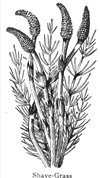 While shavegrass may be a term unfamiliar to many of us, it refers to a plant most of us know: Equisetum arvense, commonly known as water grass or horsetail. Shavegrass was heralded as an extraordinary healer of skin complaints, especially old injuries, putrid wounds and gangrenous ulcers. (Lust, 1900, p.12; Lust, 1907, p.135) A decoction made with shavegrass was considered to “the best of Nature’s cleansers [used as] a daily ablution, mornings and evenings … to keep a wound clean.” (Lust, 1901, p.300) Shavegrass, along with sage, were especially useful in a decoction that would be applied as a cold compresses on wounds. (Lust, 1902, p.348) Another way to apply shavegrass was to use “a wet cloth in which a quantity of the shavegrass has been placed and this is laid over the wound or painful part.” (Lust, 1907, p.135)
While shavegrass may be a term unfamiliar to many of us, it refers to a plant most of us know: Equisetum arvense, commonly known as water grass or horsetail. Shavegrass was heralded as an extraordinary healer of skin complaints, especially old injuries, putrid wounds and gangrenous ulcers. (Lust, 1900, p.12; Lust, 1907, p.135) A decoction made with shavegrass was considered to “the best of Nature’s cleansers [used as] a daily ablution, mornings and evenings … to keep a wound clean.” (Lust, 1901, p.300) Shavegrass, along with sage, were especially useful in a decoction that would be applied as a cold compresses on wounds. (Lust, 1902, p.348) Another way to apply shavegrass was to use “a wet cloth in which a quantity of the shavegrass has been placed and this is laid over the wound or painful part.” (Lust, 1907, p.135)
Kneipp also used shavegrass to arrest blood vomiting. (Lust, 1900, p.118) Louisa Lust, who also used herbs in her practice, considered shavegrass to be one of “the excellent herbs for hemorrhages, to stop bleeding of any kind, whether internal or external.” (Lust, 1923, p.370) Baumgarten thought of shavegrass as a powerful hemostatic herb and recommended drinking shavegrass tea whenever loss of blood took place. A formula that was very effective against hemorrhage included mistletoe and shavegrass. (Lust, 1918, p.674)
Baumgarten found shavegrass to be a simple and effective remedy for chronic gastritis (stomach catarrh). He also combined shavegrass with cleansing herbs such as wormwood and gentian in detoxing formulas. (Baumgarten, 1908, p.40) Despite its usefulness in some digestive conditions, Baumgarten warned that shavegrass is a purgative, contraindicated in cases of chronic constipation, and noted that “people suffering from diarrhea would only increase the evil by using shavegrass.” (Baumgarten, 1908, p.41)
To remove uric acid from the blood, Lust formulated a tea with “ground juniper berries, shavegrass and knotgrass to which some wormwood should be added.” (Lust, 1902, p.349)
Although we now tend to use Equisetum arvense in treating ailments of the kidneys and bladder, Kneipp and Lust considered other herbs such as knotgrass to be more effective: “Although shavegrass is also very good remedy for bladder troubles, the application of knotgrass is to be preferred.” (Lust, 1904, p.137) When shavegrass tea was taken occasionally, it helped to keep the stomach and intestines in good health. As Lust explained: “Taken daily, shavegrass tea will relieve urination ailments, kidney troubles and will ease pain in cases of stone and gravel diseases.” (Lust, 1907, p.135)
To treat colds and phlegm, shavegrass, “used as a vapor for inhaling purposes … has a marvelous healing effect upon the lungs and throat and upon the inner membranes of the nose.” (Lust, 1907, p.135)
A Nod to the Common Plant
The common herbs that formed the early naturopathic physician’s apotheca may have lacked the sizzle and dazzle of the modern pharmacopeia, which includes exotic herbs from around the globe, but they were remarkably effective. The herbs that Kneipp used and condoned were easily accessible and typically located within walking distance of people’s homes. Kneipp dearly wanted to help everyone live healthy lives, especially poor people. When we understand that Kneipp’s primary purpose was to make knowledge available to those who did not have the means to pay for expensive pharmaceuticals, we can have a deeper appreciation for the generosity of his herbal wisdom. We must not underestimate these common and neglected herbs. When we learn how they were used, we are rekindling Kneipp’s spirit as one of the forefathers of the modern naturopathic medicine movement.
References:
Baumgarten, A. (1908). Herbs for stomach troubles. The Naturopath and Herald of Health, IX (2), 40-41.
Kneipp, S. (1896). My Water Cure, Jos. Kœsel Publishers, Kempten, Bavaria, pp. 395.
Kneipp, S. (1900). My medicinal herbs. The Kneipp Water Cure Monthly, I (8), 143-144.
Kneipp, S. (1902). Kneipp’s apotheca. The Naturopath and Herald of Health, III (2), 384-386.
Lust, B. (1900). Herbs and their healing power. The Kneipp Water Cure Monthly, I (1), 11-12.
Lust, B. (1900). The Kneipp apotheca. The Kneipp Water Cure Monthly, I (7), 116-118.
Lust, B. (1901). How to heal wounds quickly by natural means.
Lust, B. (1902) Kneipp’s popular healing remedies and their application. The Naturopath and Herald of Health, III (8), 348-349.
Lust, B. (1902) Medicinal virtues of the common elder. The Naturopath and Herald of Health, VIII (7), 199.
Lust, B. (1904). Knotgrass. The Naturopath and Herald of Health, V (6), 137.
Lust, B. (1907). Medicinal virtues of shavegrass. The Naturopath and Herald of Health, VIII (5), 135.
Lust, B. (1918). Selected herbs. Herald of Health and Naturopath, XXIII (7), 674.
Lust, B. (1919). Selected herbs. Herald of Health and Naturopath, XXIV (3), 144.
Lust, L. (1923). Herbs combined with nature cure. The Naturopath, XXVIII (8), 370-371.
Young, M. G. (1917). Elder. Herald of Health and Naturopath, XXII (3), 169-170.
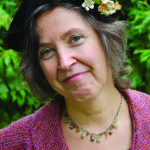 Sussanna Czeranko ND, BBE, incorporates “nature-cure” approaches to primary care by including balneotherapy, breathing therapy, and nutrition into her naturopathic practice. Dr Czeranko is a faculty member working as the Rare Books curator at NCNM and is currently compiling a 12-volume series based upon Benedict Lust’s journals, published early in the last century. Her published books include: Origins of Naturopathic Medicine; Philosophy of Naturopathic Medicine; Dietetics of Naturopathic Medicine; Principles of Naturopathic Medicine; Vaccination and Naturopathic Medicine; and Physical Culture in Naturopathic Medicine. Dr Czeranko is the founder of the Breathing Academy, a training institute for naturopaths to incorporate a scientific model of breathing therapy called Buteyko into their practice. She is also a founding board member of the International Congress of Naturopathic Medicine and a member of the International Society of Medical Hydrology.
Sussanna Czeranko ND, BBE, incorporates “nature-cure” approaches to primary care by including balneotherapy, breathing therapy, and nutrition into her naturopathic practice. Dr Czeranko is a faculty member working as the Rare Books curator at NCNM and is currently compiling a 12-volume series based upon Benedict Lust’s journals, published early in the last century. Her published books include: Origins of Naturopathic Medicine; Philosophy of Naturopathic Medicine; Dietetics of Naturopathic Medicine; Principles of Naturopathic Medicine; Vaccination and Naturopathic Medicine; and Physical Culture in Naturopathic Medicine. Dr Czeranko is the founder of the Breathing Academy, a training institute for naturopaths to incorporate a scientific model of breathing therapy called Buteyko into their practice. She is also a founding board member of the International Congress of Naturopathic Medicine and a member of the International Society of Medical Hydrology.

